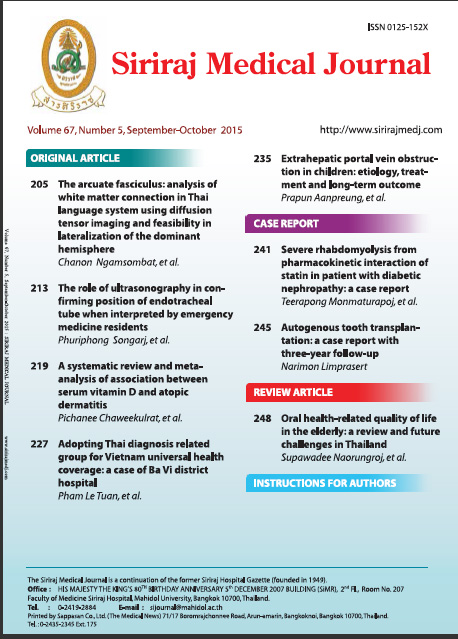The arcuatefasciculus : Analysis of white matter connection in Thai language system using diffusion tensor imaging
Abstract
Objective: The arcuate fasciculus (AF) is classically described as white matter connecting Broca’s and Wernicke’s area, which is important for language processing in human. In previous study, lateralization of the AF to the left in normal healthy people was described. However, using of AF for lateralization of the dominant hemisphere in Thai speakers with Thai mother tongue language has not been studied. The purpose of this study was to demonstrate any possibility that AF (by diffusion tensor imaging (DTI)) could be used to lateralize the dominant hemisphere in native-Thai speakers.
Materials and Methods: Ten normal official Thai speakers with Thai mother tongue language (5 male, 5 female, mean age 24.9 years old; range 22-37 years old) were studied with DTI by 3T MRI using deterministic method in post processing software. The fractional anisotropy (FA), relative fiber density index (RFD) and asymmetry index (AI) were analyzed to determine the dominant hemisphere. Comparison to functional hemispheric language lateralization from functional magnetic resonance imaging (fMRI) was done.
Results: The FA was slightly lateralized to the left in all subjects. The lateralization to the right of RFD were found in 5 subjects, to the left in 3 subjects and no definite lateralization in 2 subjects. The lateralization to the right of AI was found in 5 subjects, to the left in 3 subjects and no definite lateralization in 2 subjects. The lateralization from the fMRI language paradigm using visual analysis of all subjects were to the left. The anterior end of the AF tract was at par opercularis in 6, par triangularis in 3 and middle frontal gyrus in 5 subjects. The posterior end of the AF was at superior temporal gyrus in 7, middle temporal gurus in 9 and angular gyrus in 4 subjects. The area of termination of the AF was not correlated with activation from fMRI in 6 subjects when fusion with word paradigm and in 7 subjects when fusion with verb paradigm.
Conclusion: The way to reconstruct the AF is feasible with practical method and software. However its clinical value to determine the dominant hemisphere in Thai subject is needed to be more explored with more advance and promised technique.
Keywords:Arcuate fasciculus; Diffusion tensor imaging; Thai language; Dominant hemisphere
Downloads
Published
How to Cite
Issue
Section
License
Authors who publish with this journal agree to the following conditions:
Copyright Transfer
In submitting a manuscript, the authors acknowledge that the work will become the copyrighted property of Siriraj Medical Journal upon publication.
License
Articles are licensed under a Creative Commons Attribution-NonCommercial-NoDerivatives 4.0 International License (CC BY-NC-ND 4.0). This license allows for the sharing of the work for non-commercial purposes with proper attribution to the authors and the journal. However, it does not permit modifications or the creation of derivative works.
Sharing and Access
Authors are encouraged to share their article on their personal or institutional websites and through other non-commercial platforms. Doing so can increase readership and citations.











